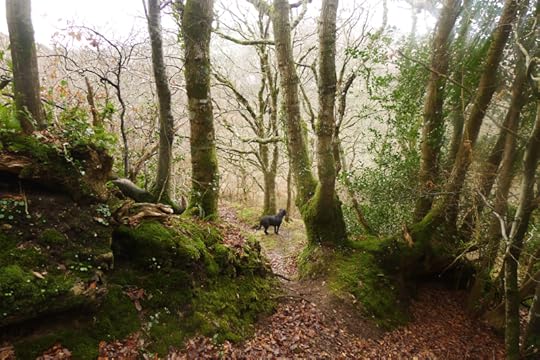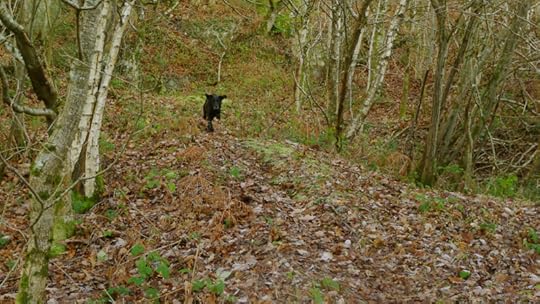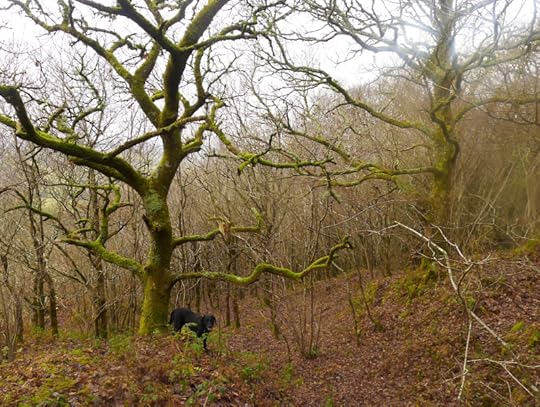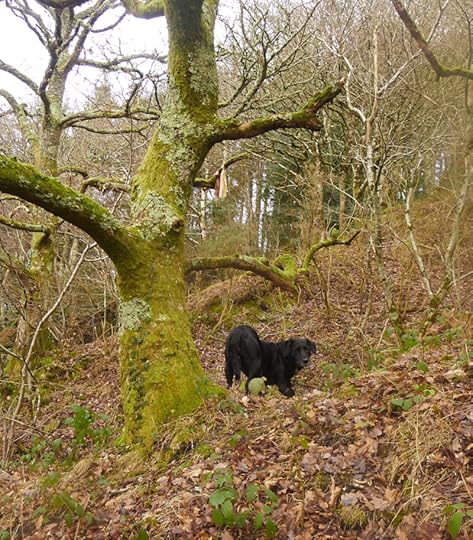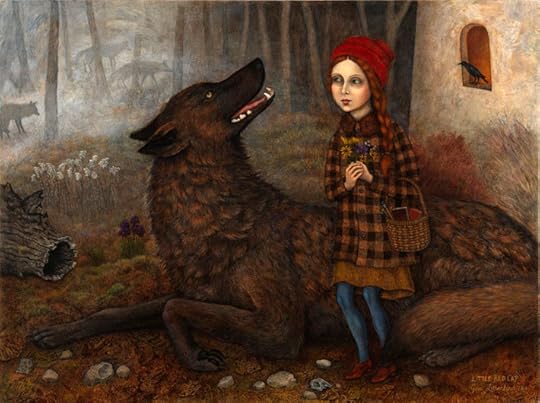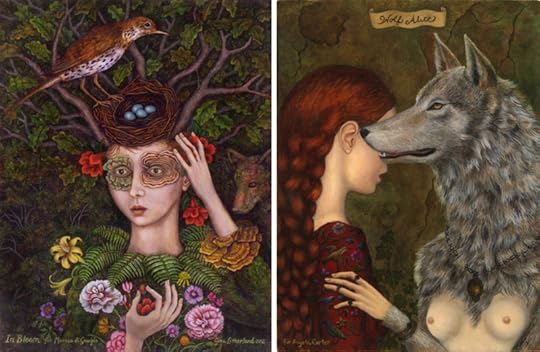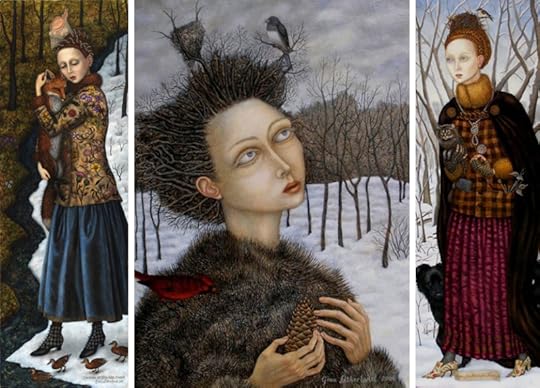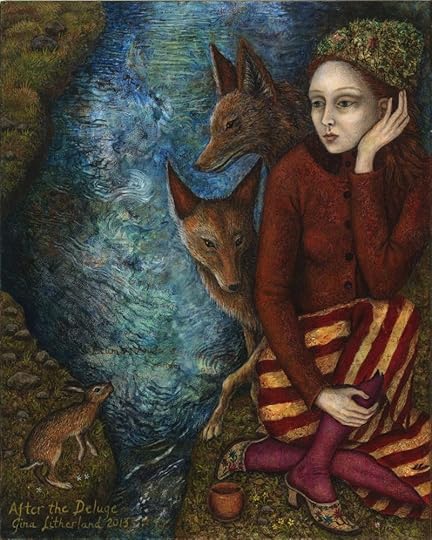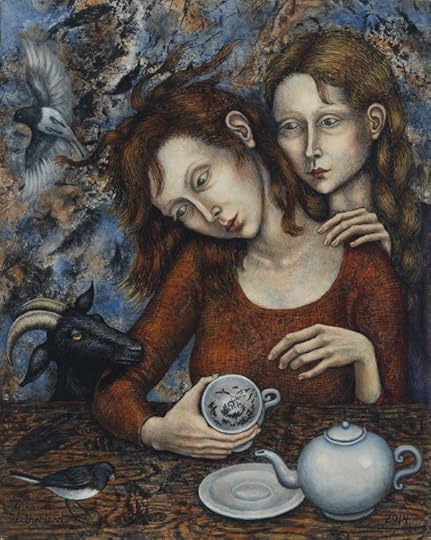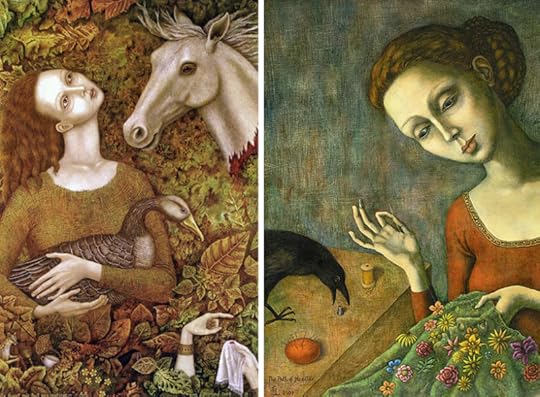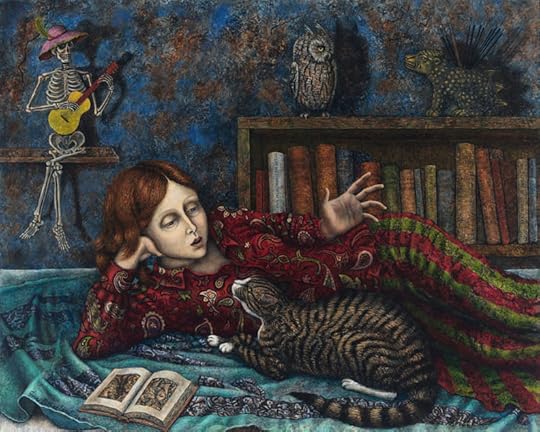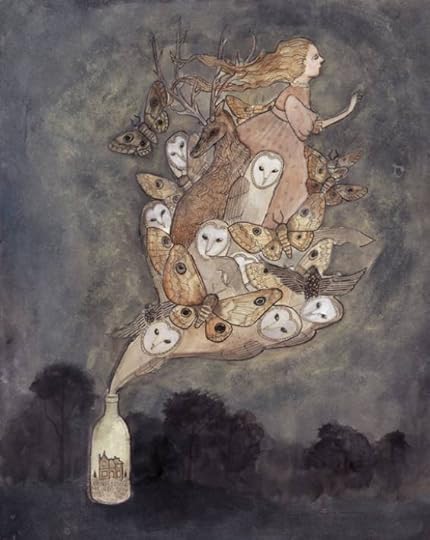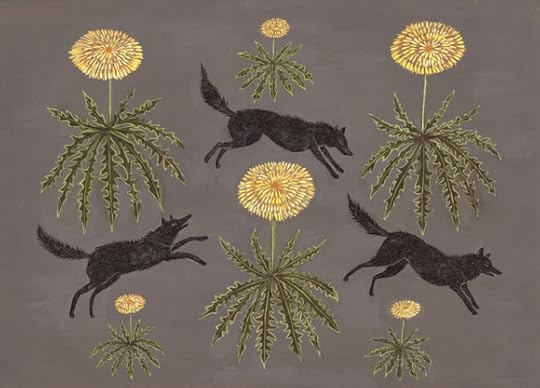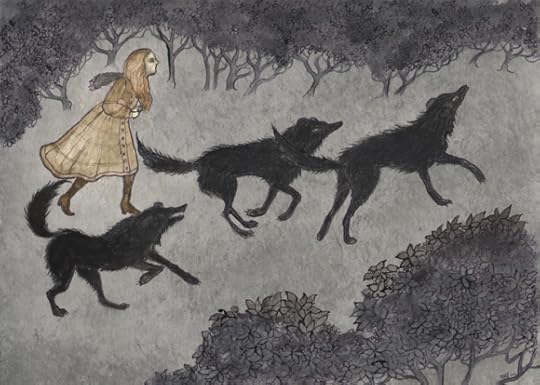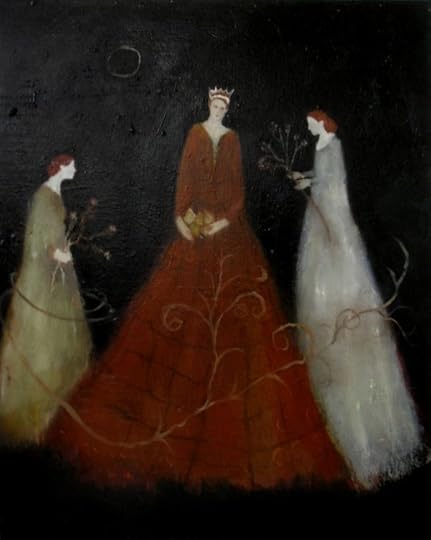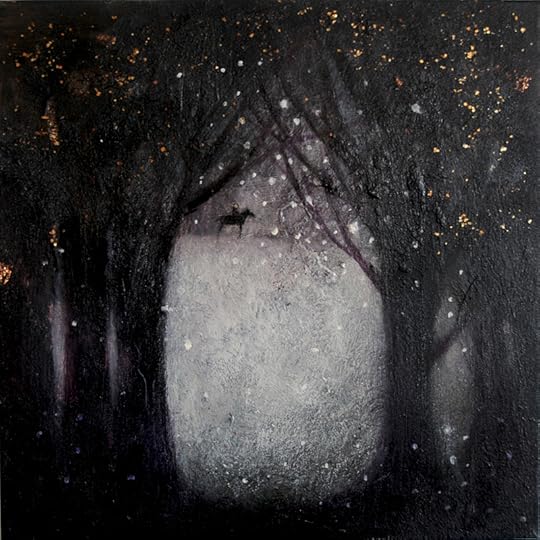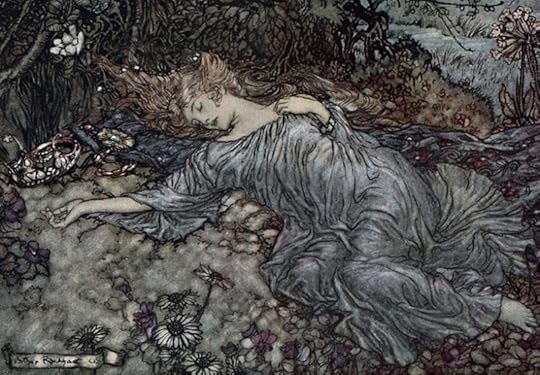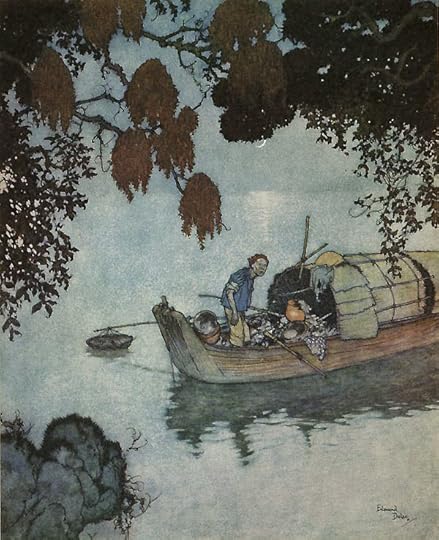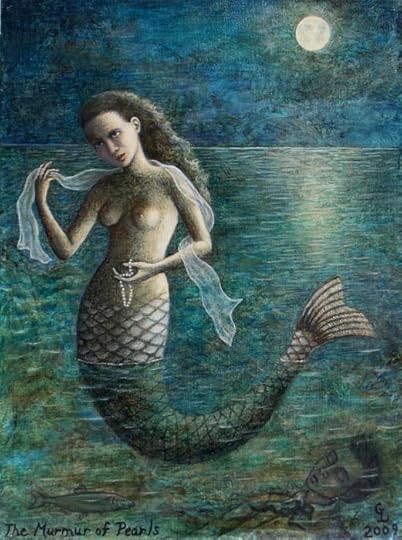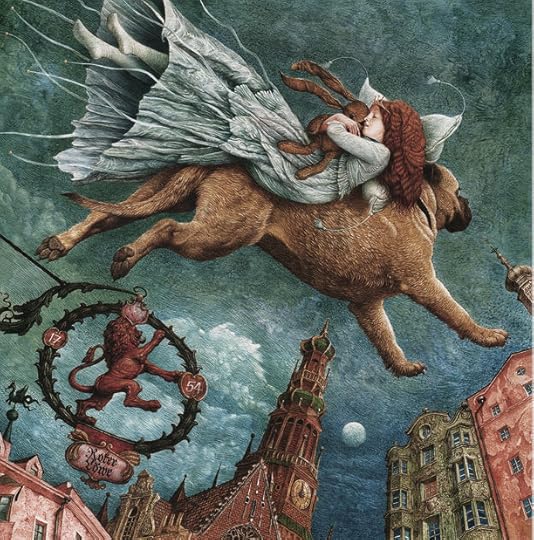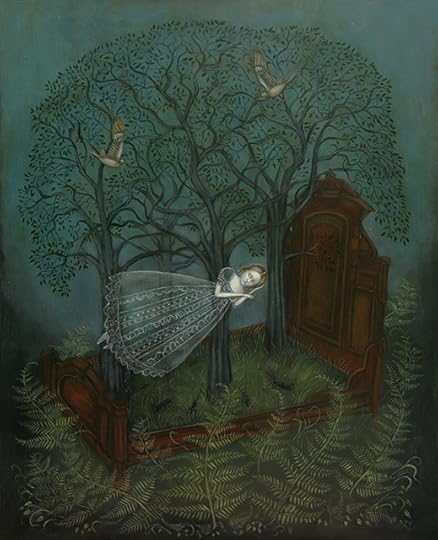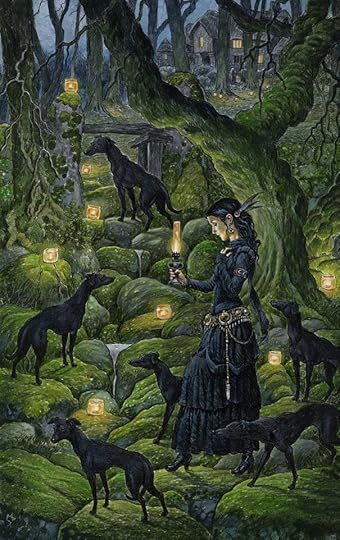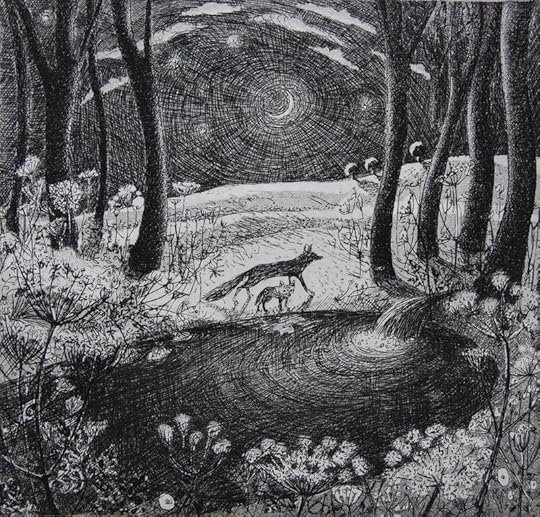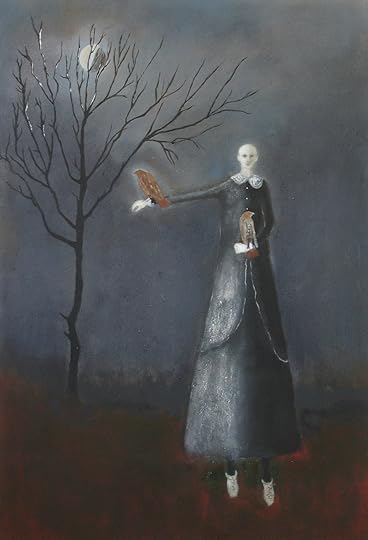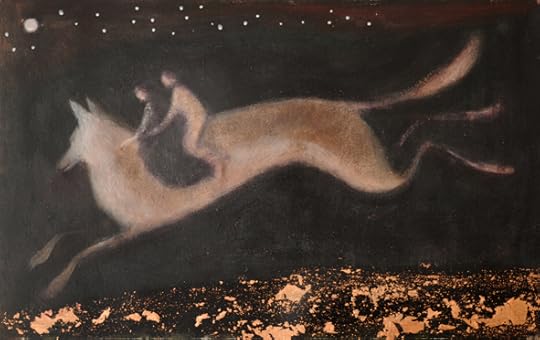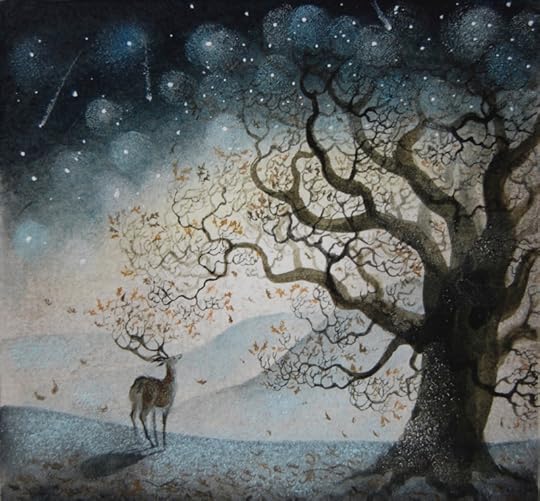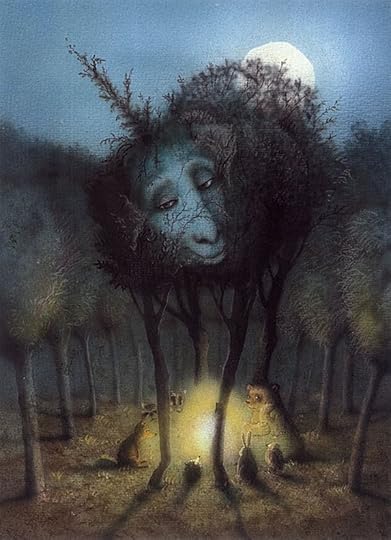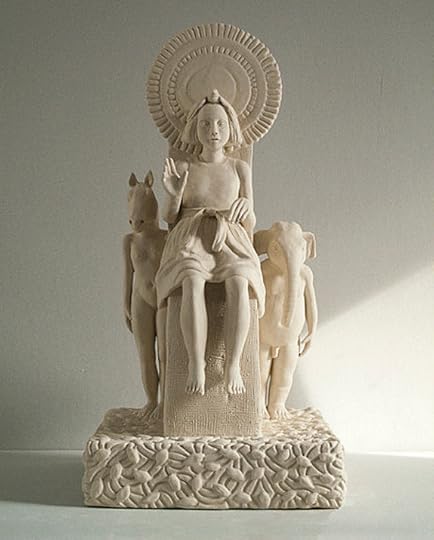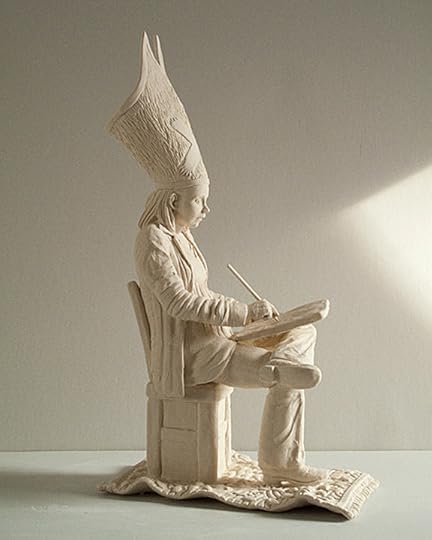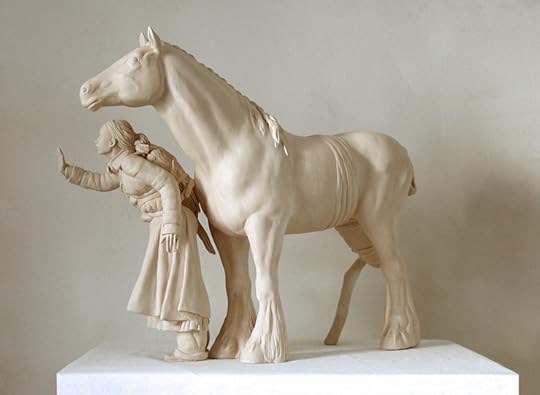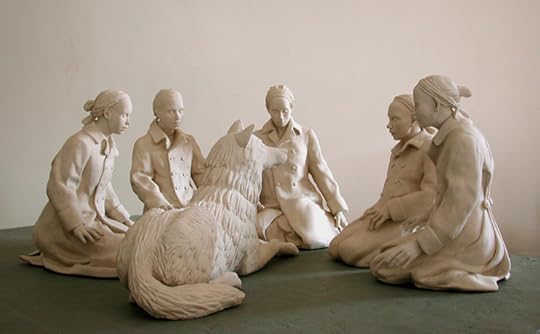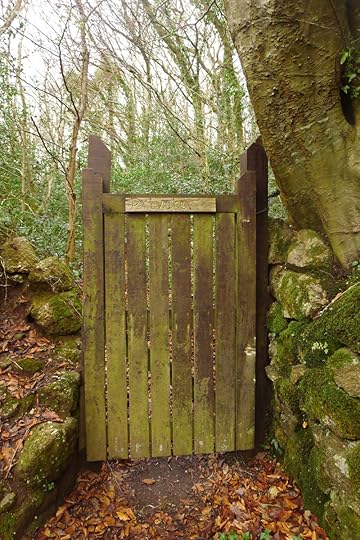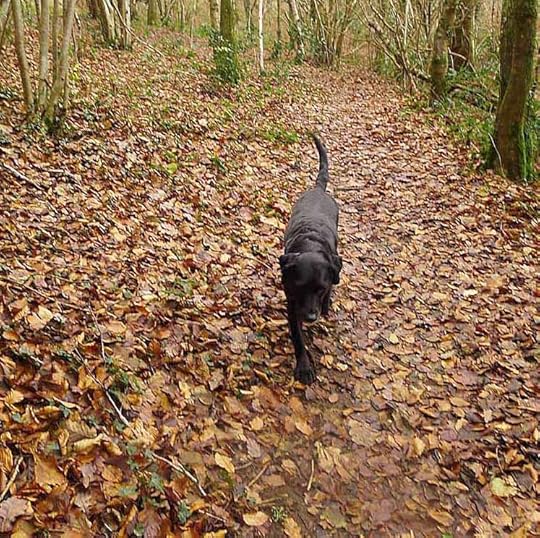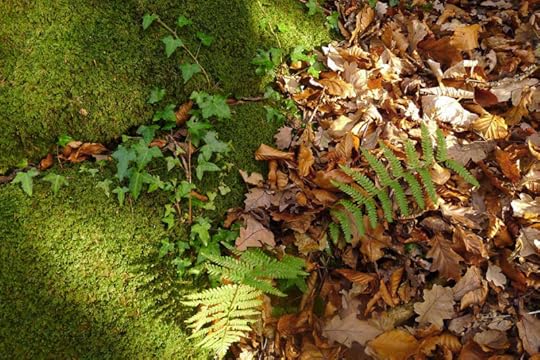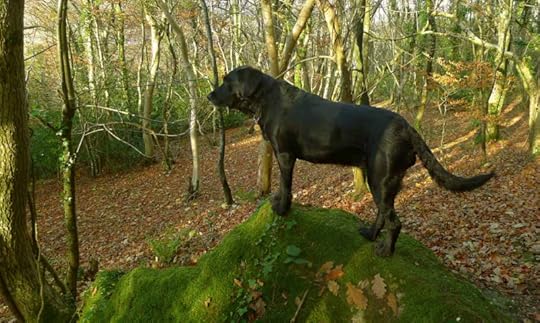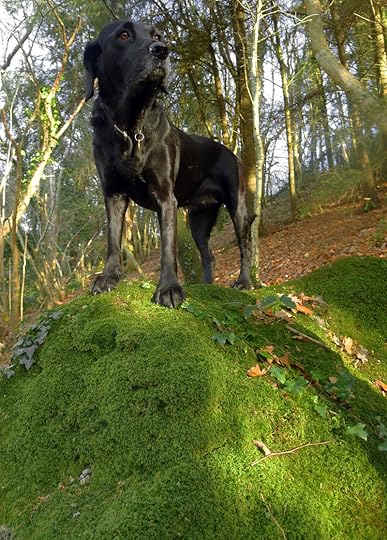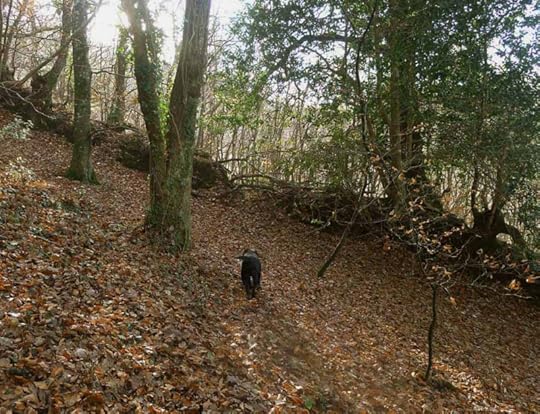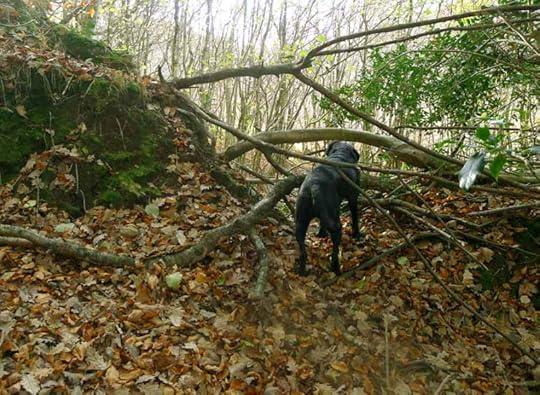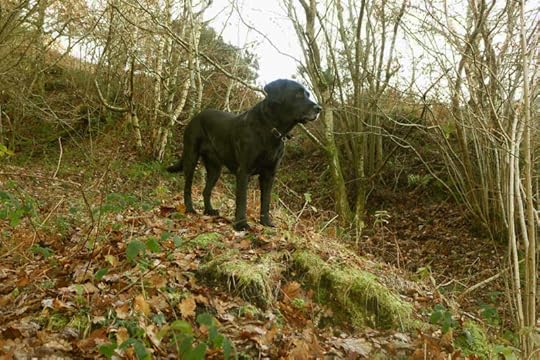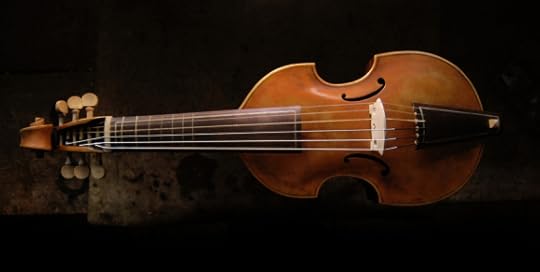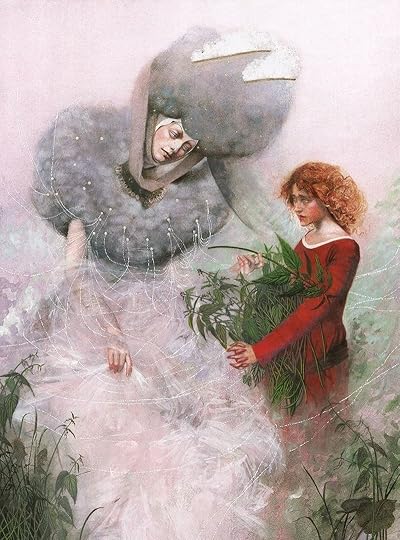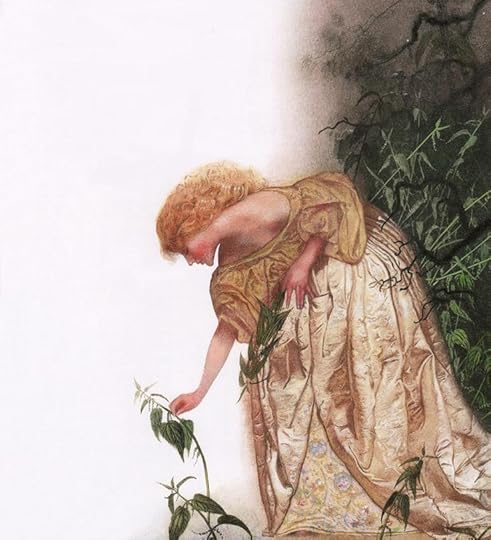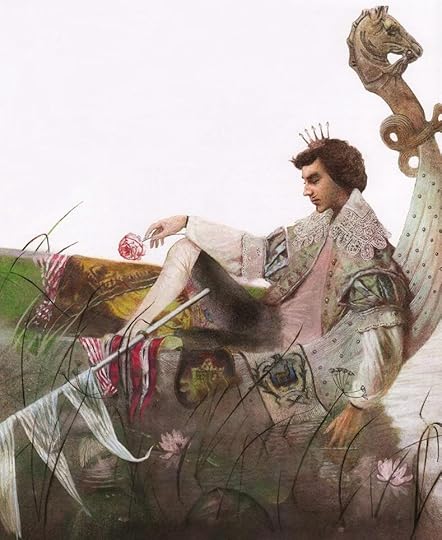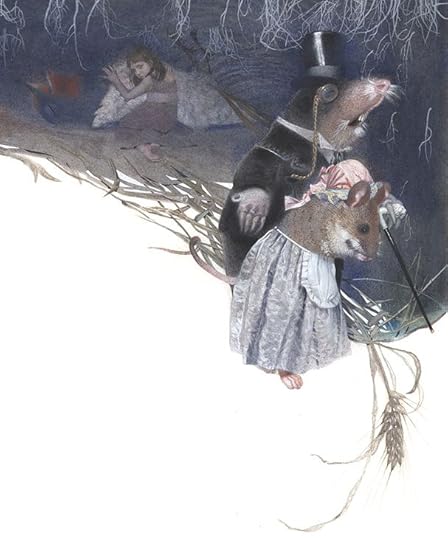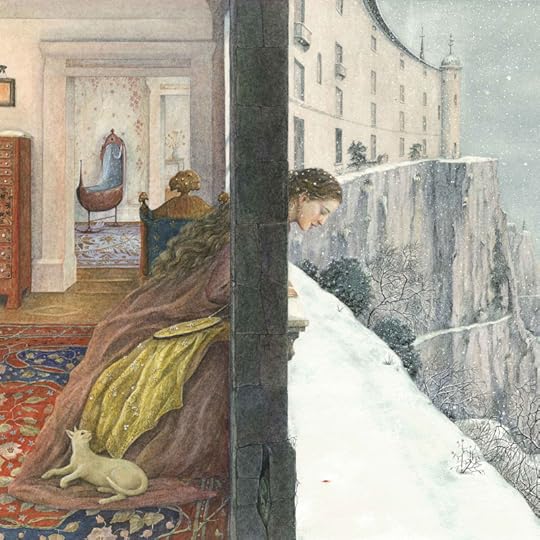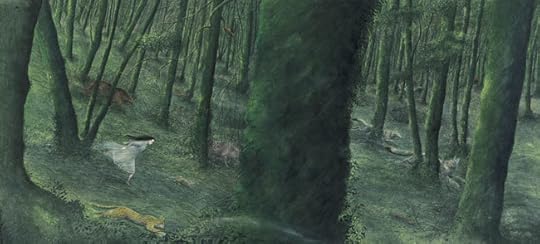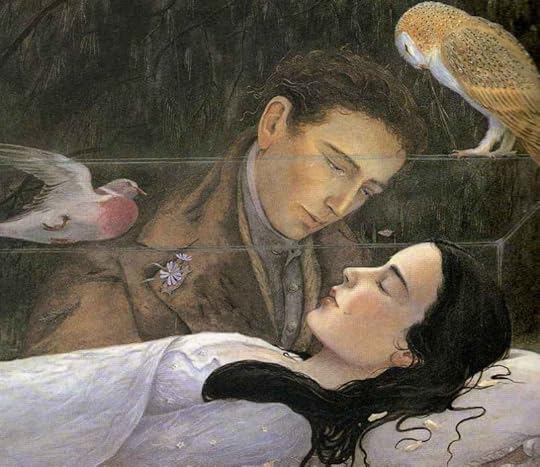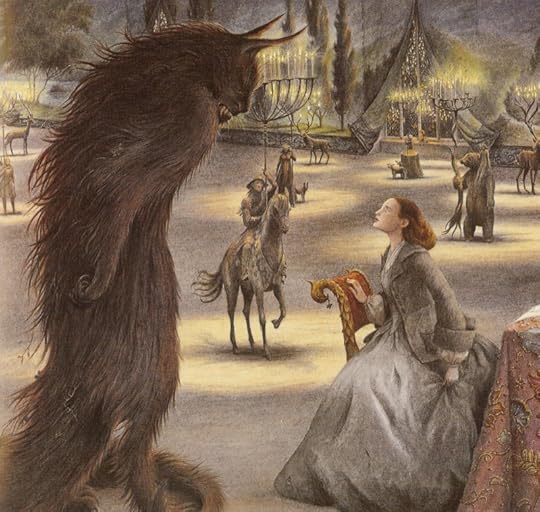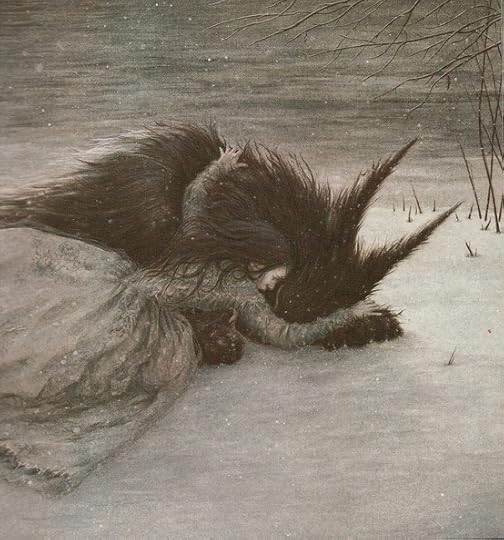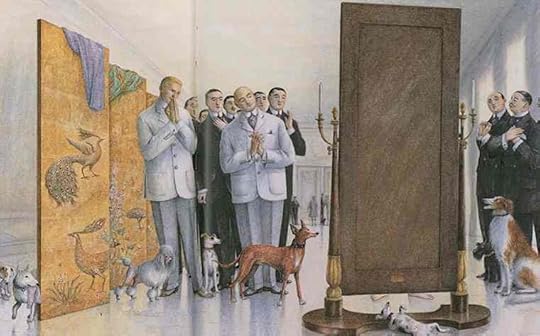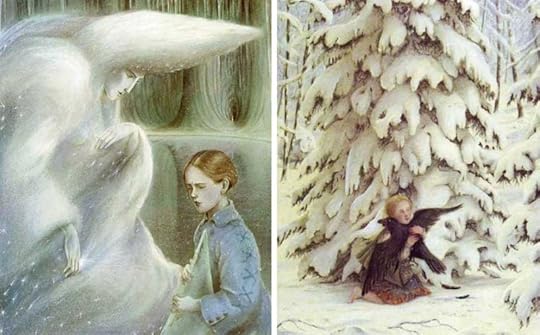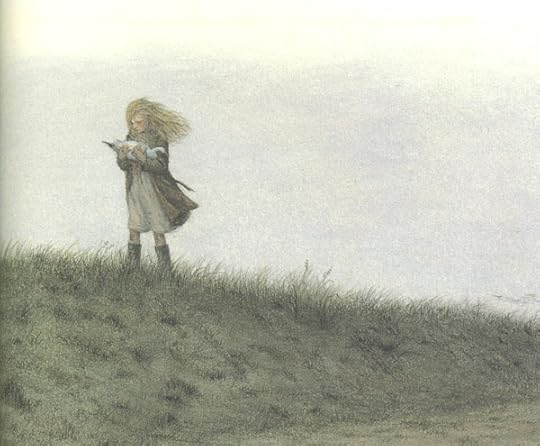Terri Windling's Blog, page 98
January 25, 2017
Visiting the cloutie tree
Winter
by Holly Black
Like coughing a bite of apple from a slender throat
Like a grandmother reborn from a wolf's belly
Like slipping a foot into a glass shoe
Like a frog prince thrown against a wall
We slough off the skin of the old year
And wait for what's underneath to toughen.
The photographs today are of the "cloutie tree" (or "wish tree") near my studio, in its mossy winter guise. For more about the folklore of clouties, see this previous post: "The Blessings of the Trees."
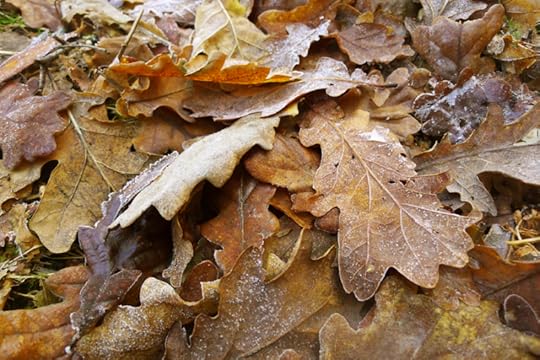 Holly Black's poem first appeared in
The Journal of Mythic Arts
(2008). The poem in the picture captions is from
The Thing that Mattered Most: Scottish Poems for Children
, edited by Julie Johnstone (Scottish Poetry Livrary, 2006). All rights reserved by the authors.
Holly Black's poem first appeared in
The Journal of Mythic Arts
(2008). The poem in the picture captions is from
The Thing that Mattered Most: Scottish Poems for Children
, edited by Julie Johnstone (Scottish Poetry Livrary, 2006). All rights reserved by the authors.
January 24, 2017
When you enter the woods...
"When you enter the woods of a fairy tale, it is night and trees tower on either side of the path. They loom large because everything in the world of fairy tales is blown out of proportion. If the owl shouts, the otherwise deathly silence magnifies its call. The tasks you are given to do (by the witch, by the stepmother, by the wise old woman) are insurmountable -- pull a single hair from the crescent moon bear's throat; separate a bowl's worth of poppy seeds from a pile of dirt. The forest seems endless. But when you do reach the daylight, triumphantly carrying the particular hair or having outwitted the wolf; when the owl is once again a shy bird and the trees only a lush canopy filtering the sun, the world is forever changed for your having seen it otherwise.
"From now on, when you come upon darkness, you'll know it has dimension. You'll know how closely poppy seeds and dirt resemble each other. The forest will be just another story that has absorbed you, taken you through its paces, then cast you out and sent you back home again."
- Elizabeth J. Andrew (On the Threshold)
"Step across the boundary and the trespass of story will begin. The forest takes a deep breath and through its whispering leaves an incipient adventure unfurls. The quest. In the lull -- not the drowsy lull of a lullaby but the sotto voce of a woodland clearing, scented with story as it is with with wild garlic -- this is the moment of beginning, the pause on the threshold before the journey. So many tales begin here, hard by a great forest...."
- Jay Griffiths (Kith: The Riddle of the Childscape)
"I did not want to think about people. I wanted the trees, the scents and colors, the shifting shadows of the wood, which spoke a language I understood. I wished I could simply disappear in it, live like a bird or a fox through the winter, and leave the things I had glimpsed to resolve themselves without me."
- Patricia A. McKillip (Winter Rose)
"It���s not by accident that people talk of a state of confusion as not being able to see the wood for the trees, or of being out of the woods when some crisis is surmounted. It is a place of loss, confusion, terror and anger, a place where you can, like Dante, find yourself going down into Hell. But if it���s any comfort, the dark wood isn���t just that. It���s also a place of opportunity and adventure. It is the place in which fortunes can be reversed, hearts mended, hopes reborn."
- Amanda Craig (In a Dark Wood)
"What if we turned the old nursery rhymes and fairytales we all know into feral creatures once again, set them loose in new lands to root through the acorn fall of oak trees? What else is there to do, if we want to keep any of the wildness of the world, and of ourselves?"
- Sylvia Linsteadt ("Turning Our Fairytales Feral Again," Dark Mountain and Resilience)
The fairy tale infused art today is by American painter Gina Litherland. Born in Gary, Indiana, she received a BFA from the School of the Art Institute of Chicago in 1984, and has exhibited in museums and galleries throughout the United States.
"I have always been interested in the interplay between myth, the natural world, and the domain of dreams and memory," she says. "As a child, I spent many hours exploring natural wooded areas and empty lots inhabited by multitudes of insects and wildlife. This, along with a fervent interest in reading, particularly fairy tales, laid the foundation for my current investigations as an artist. Much of my work is inspired by folklore, myth, and literature reflected in my own personal preoccupations, specifically themes of desire, femaleness, the natural world, the human/animal boundary, children's games, ritual, intuition, and memory. The painting techniques that I use, traditional indirect oil painting techniques similar to those used by fifteenth century Sienese painters, combined with textural effects created by using various tools other than the paint brush, allow me to create a detailed, layered, and complex surface of images recreating the experience of looking at the forest floor with its rich blanket of diverse matter in various stages of decay. Suddenly, an object emerges and comes sharply into focus."
Go here to read an interview with the artist by Don LeCoss, and here to see her work in the "Hidden Rooms" show at Corbett vs. Dempsey in Chicago, 2016.
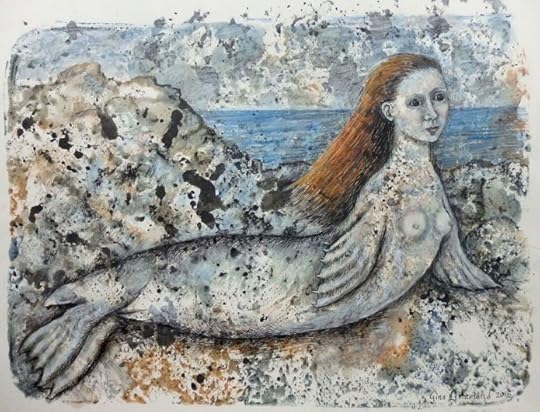 The art by Gina Litherland is: Little Red Cap, In Bloom, Wolf Alice (inspired by an Angela Carter story), Crossing an Iced-over Stream, a wintery figure (title unknown), Queen of An Uncharted Territory, After the Deluge, Reading the Leaves, Goose Girl, The Path of Needles, Conversation With a Cat, and Selkie. All rights to the text and art above reserved by the authors and artist.
The art by Gina Litherland is: Little Red Cap, In Bloom, Wolf Alice (inspired by an Angela Carter story), Crossing an Iced-over Stream, a wintery figure (title unknown), Queen of An Uncharted Territory, After the Deluge, Reading the Leaves, Goose Girl, The Path of Needles, Conversation With a Cat, and Selkie. All rights to the text and art above reserved by the authors and artist.
January 22, 2017
Tunes for a Monday Morning
Since the theme of "darkness" keeps emerging here, on the wings of owls and the breath of wolves, let's start the week with music that is brewed in dreams, night journeys, and the darker side of fairy tales....
All four songs today are by the Irish alt-folk duo Saint Sister : Gemma Doherty (from Derry) and Morgan MacIntyre (from Belfast). Their music "draws from early Celtic harp traditions, 60s folk and electronic pop to create ���atmosfolk' -- a mix of soulful vocal harmonies, dreamy synth and electro-acoustic harp."
Above: "Madrid" (2015), from Saint Sister's debut EP of the same name. The darkly folkloric video was directed by Bob Gallagher.
Below: "Blood Moon" (2015). The video was shot in Donegal, directed by Myrid Carten and Aphra Lee Hill.
Above: Bob Gallagher's dreamlike video for "Tin Man," released two months ago.
Below: Doherty and McIntyre in a quietly atmospheric performance of their new song, "Corpses."
The art today is by Kelly Louise Judd, a painter and illustrator from Kansas City, Missouri whose work is inspired by folklore, ghost stories, Victorian literature and art, Northern Renaissance art, animals and nature. Please visit her website, blog, and Swans Bones Etsy shop to see more.
January 19, 2017
By the Light of the Moon and Stars
Fridays are now my day for reprinting posts from Myth & Moor's extensive archives. This one, from summer 2013, is a compilation of paintings and drawings on the theme of "night" -- re-posted today with additional art. It relates to discussions over the last couple of weeks on darkness, night journeys, and the calling of the owls.
"The world rests in the night," writes John O'Donohue. "Trees, mountains, fields, and faces are released from the prison of shape and the burden of exposure. Each thing creeps back into its own nature within the shelter of the dark. Darkness is the ancient womb. Night-time is womb-time. Our souls come out to play...."
"Sometimes, when you're deep in the countryside, you meet three girls, walking along the hill tracks in the dusk, spinning. They each have a spindle, and on to these they are spinning their wool, milk-white, like the moonlight. In fact, it is the moonlight, the moon itself, which is why they don't carry a distaff. They're not Fates, or anything terrible; they don't affect the lives of men; all they have to do is to see that the world gets its hours of darkness, and they do this by spinning the moon down out of the sky. Night after night, you can see the moon getting less and less, the ball of light waning, while it grown on the spindles of the maidens. Then, at length, the moon is gone, and the world has darkness, and rest." - Mary Stewart (The Moonspinners)
"Night falls. Or has fallen. Why is it that night falls, instead of rising, like the dawn? Yet if you look east, at sunset, you can see night rising, not falling; darkness lifting into the sky, up from the horizon, like a black sun behind cloud cover. Like smoke from an unseen fire, a line of fire just below the horizon, brushfire or a burning city. Maybe night falls because it���s heavy, a thick curtain pulled up over the eyes. A wool blanket." - Margaret Atwood (A Handmaid's Tale)
"Night does not show things, it suggests them. It disturbes and surprises us with its strangeness. It liberates forces within us which are dominated by our reason during the daytime." - Brassa��
"The message of the lullaby is that it���s okay to dim the eyes for a time, to lose sight of yourself as you sleep and as you grow: if you drift, it says, you���ll drift ashore: if you fall, you will fall into place." - Kevin Brockmeier ("These Hands")
"Anything seems possible at night when the rest of the world has gone to sleep." - David Almond (My Name is Mina)
"Night is a time of rigor, but also of mercy. There are truths which one can see only when it���s dark." - Isaac Bashevis Singer (Teibele And Her Demon)
"Our fantastic civilization has fallen out of touch with many aspects of nature, and with none more completely than with night. Primitive folk, gathered at a cave mouth round a fire, do not fear night; they fear, rather, the energies and creatures to whom night gives power; we of the age of the machines, having delivered ourselves of nocturnal enemies, now have a dislike of night itself. With lights and ever more lights, we drive the holiness and beauty of night back to the forests and the sea; the little villages, the crossroads even, will have none of it.
"Are modern folk, perhaps, afraid of night? Do they fear that vast serenity, the mystery of infinite space, the austerity of stars? Having made themselves at home in a civilization obsessed with power, which explains its whole world in terms of energy, do they fear at night for their dull acquiescence and the pattern of their beliefs? Be the answer what it will, today's civilization is full of people who have not the slightest notion of the character or the poetry of night, who have never even seen night. Yet to live thus, to know only artificial night, is as absurd and evil as to know only artificial day." - Henry Beston (The Outermost House)
Look, as the day slows towards the space
that draws it into dusk: rising became
upstanding, standing a laying down, and then
that which accepts its lying blurs to darkness.
Mountains rest, outgloried be the stars -
but even there, time���s transition glimmers.
Ah, nightly refuged in my wild heart,
roofless, the imperishable lingers.
- Rainer Maria Rilke (Uncollected Poems: 1912-1922, translation by Susan Ranson & Marielle Sutherland)
"This is the ending. Now not day only shall be beloved, but night too shall be beautiful and blessed and all its fear pass away." - J.R.R. Tolkien (The Return of the King)

The illustrations above are : "Trolls" by John Bauer (1882-1918), "Celestial Pablum" by Remedios Varo (1908-1963),
"Presently" by Jeanie Tomanek, "The Woods are Lovely, Dark and Deep" by Catherine Hyde, "The Arabian Nights: Descent" by Edmund Dulac (1882-1953), a drawing from the "Inner Seasons" series by Virginia Lee, "A Midsummer Night's Dream" by Arthur Rackham (1887-1969),
"Kip the Enchanted Cat" by Adrienne
S��gur (1901-1981), "The Nightingale: The Fisherman Stops to Listsen" by Edmund Dulac (1882-1953), "Murmur of Pearls" by Gina Litherland, "The Tin Soldier: The Dog Carries the Princess on His Back" by Vladislav Erko, "The Fairy Procession" by Charles Vess, "A Midsummer Night's Dream: Oberon and Titania" by
Arthur Rackham (1887-1969), "Forest Sleep" by Kelly Louise Judd, "Marianna and the Whippets" by David Wyatt, "The Hidden Pool" by Flora McLachlan, "Eclipse" by Jeanie Tomanek,
"Crossing the River" by Catherine Hyde, "Starfall" by Flora McLachlan, "The Wind and the Willows" by Inga Moore, and "The Legendary Unicorn" by Julia Gukova. All rights to the imagery and text above are reserved by the artists and authors.
January 18, 2017
The Longest Night
The title of this magical animation by Angie Pickman refers to the winter solstice, but it's also symbolic of other "long nights" we face in life: a mental or physical health crisis...a period of grief, hardship, or trauma...or the week leading to a troubling transition of power in Washington DC.
"We are always on a journey from darkness into light," the Irish poet/philosopher John O'Donohue reminds us. "At first, we are children of the darkness. Your body and your face were formed first in the kind darkness of your mother's womb. You lived the first nine months in there. Your birth was the first journey from darkness into light. All your life, your mind lives within the darkness of your body. Every thought you have is a flint moment, a spark of light from your inner darkness. The miracle of thought is its presence in the night side of your soul; the brilliance of thought is born of darkness. Each day is a journey. We come out of the night into the day. All creativity awakens at this primal threshold where light and darkness test and bless each other. You only discover the balance in your life when you learn to trust the flow of this ancient rhythm."
In the mythic sense, we have practiced moving from darkness into light every morning of our lives. The task now is make that movement larger, to join together to carry the entire world through the long night to the dawn.
The art above is"The Spirit Within" by Karen Davis; "Stray" and "Capturing the Moon" by Jeanie Tomanek. The quote is from Anam Cara by John O'Donhue (Bantam Books, 1997). All right reserved by the artists, and the author's estate.
January 17, 2017
A writer's pledge
Some time ago I stumbled across these words by children's book writer Cornelia Funke (author of The Thief Lord, Inkheart, etc.), and they've been pinned to the wall above my desk ever since:
"I pledge to use books as doors to other minds, old and young, girl and boy, man and animal.
"I pledge to use books to open windows to a thousand different worlds and to the thousand different faces of my own world.
"I pledge to use books to make my universe spread much wider than the world I live in every day.
"I pledge to treat my books like friends, visiting them all from time to time and keeping them close."
"In America lately," writes Scott Russell Sanders, "we have been carrying on two parallel conversations: one about respecting human diversity, the other about preserving natural diversity. Unless we merge those conversations, both will be futile. Our efforts to honor human differences cannot succeed apart from our effort to honor the buzzing, blooming, bewildering variety of life of earth. All life rises from the same source, and so does all fellow feeling, whether the fellow moves on two legs or four, on scaly bellies or feathered wings. If we care only for human needs, we betray the land; if we care only for the earth and its wild offspring, we betray our own kind. The profusion of creatures and cultures is the most remarkable fact about our planet, and the study and stewardship of that profusion seems to me our fundamental task."
Words to live by.
The art today is by Tricia Cline, a sculptor from northern California who works primarily in porcelain. The pieces here are from her extensive "Exiles from Lower Utopia" series, created as an ode to the Animal.
Cline says: "This is the ode: to reconnect with our own animal perception is to clarify and heighten our perception of who and what we are in the moment���to go beyond the limited mental concepts of who we think we are to an awareness of ourselves that is infinitely more vast. The Exiles migrate between the human world and the animal world and carry this awareness on their backs. They are the silent embodiment of this Quest. They understand the language of animals and are self-appointed ambassadors from that world."
More of Cline's work can be seen in a previous post (March 5, 2015), and on the artist's website.
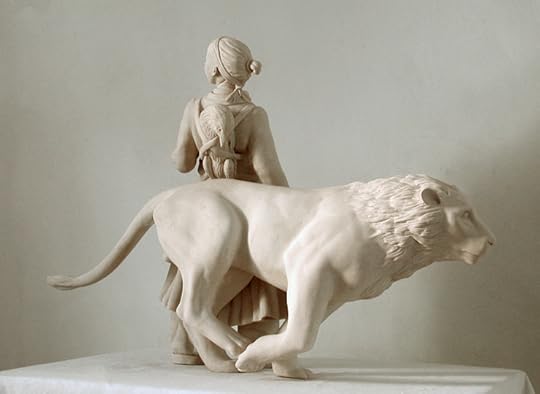 The Scott Russell Sanders quote is from his essay collection Writing from the Center (Indiana University Press, 1997). I'm afraid I have no idea where the Cornelia Funke quote originally appeared. All rights to the text and art above reserved by the authors and artist.
The Scott Russell Sanders quote is from his essay collection Writing from the Center (Indiana University Press, 1997). I'm afraid I have no idea where the Cornelia Funke quote originally appeared. All rights to the text and art above reserved by the authors and artist.
Listening is an act of community
This week has a dark significance: it is the time of year, statistically, when the most suicides take place; and the majority of those suicides are related to depression.
Depression is on a sharp rise in the West, increasingly afflicting our young people -- and young men in particular. Several conversations with friends this last week have centered on what we -- as writers, as artists, as members of geographic and artistic communities -- can do to support younger generations to grow into lives that are mentally healthy, balanced, grounded in values beyond the marketplace, and connected to the physical, natural world, to the numinous, and to each other.
Art plays a role in this, of course, for the imagery we put out into the world helps to shape it, for good or for ill..and each of us is responsible for our small part in the collective creation.
"Young human beings need exercises in imagination as they need exercise in all the basic skills of life, bodily and mental: for growth, for health, for compentence, for joy," writes Ursula K. Le Guin. "This need continues as long as the mind is alive.
"When children are taught to learn the central literature of their people, or, in literate cultures, to read and understand it, their imagination is getting a very large part of the exercise it needs.
"Nothing else does quite as much for most people, not even the other arts," Le Guin continues. "We are a wordy species. Words are the wings both intellect and imagination fly on. Music, dance, visual arts, crafts of all kinds, all are central to human development and well-being, and no art or skill is ever useless learning; but to train the mind to take off from immediate reality and return to it with new understanding and new strength, nothing quite equals poem and story.
"Through story, every culture defines itself and teaches its children how to be people and members of their people -- Hmong, !Kung, Hopi, Quechua, French, Californian....We are those who arrived at the Fourth World.... We are Joan's nation.... We are sons of the Sun.... We came from the sea.... We are people who live at the center of the world.
"A people that doesn't live at the center of the world, as defined and described by its poets and storytellers, is in a bad way. The center of the world is where you live fully, where you know how things are done rightly, done well.
"A child who does not know where the center is -- where home is, what home is -- that child is in a very bad way.
"Home isn't Mom and Dad and Sis and Bud. Home isn't where they have to let you in. It's not a place at all. Home is imaginary.
"Home, imagined, comes to be. It is real, realer than any other place, but you can't get to it unless your people show you how to imagine it -- whoever your people are. They may not be your relatives. They may never have spoken your language. They may have been dead for a thousand years. They may be nothing but words printed on paper, ghosts of voices, shadows of minds. But they can guide you home. They are your human community.
"All of us have to learn how to invent our lives, make them up, imagine them. We need to be taught these skills; we need guides to show us how. Without them, our lives get made up for us by other people....What a child needs, what we all need, is to find some other people who have imagined life along lines that make sense to us and allow us freedom, and listen to them. Not hear passively, but listen.
"Listening is an act of community, which takes space, time, and silence.
"Reading is an act of listening."
The passage above comes from Le Guin's 2002 essay "The Operating Instructions," which I recommend reading in full. You'll find it in her excellent new collection Words Are My Matter: Writings About Life & Books, 2000-2016 (Small Beer Press, 2016).
Related reading:
* Danuta Kean's recent article "Library cuts harm young people's mental health services" (The Guardian, January 13, 2017)
* Jane Yolen on the value of fantasy in "Children, reading and Tough Magic" (Myth & Moor, August 26, 2016)
* My own thoughts about early storybooks in "The stories we need" (Myth & Moor, February 25, 2016)
* Jay Griffiths on children and nature: "In the forest, the child. In the child, the forest" (Myth & Moor, June 11, 2015).
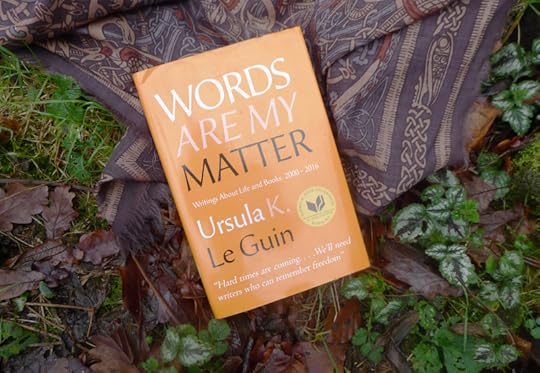 The text above is from "The Operating Instructions," a talk given at a meeting of Oregon Literary Arts in 2002, and reprinted in Words Are My Matter (Small Beer Press, 2016). All rights reserved by the author.
The text above is from "The Operating Instructions," a talk given at a meeting of Oregon Literary Arts in 2002, and reprinted in Words Are My Matter (Small Beer Press, 2016). All rights reserved by the author.
January 16, 2017
Tunes for a Monday Morning
This is going to be a very tough week for many people, particularly in America, so let's start the day off with music that is soul-lifting, timeless, and crosses all borders....
Above: "Folia: Op.Vn.12 - Rome, 1 Gennaio" by Italian composer Arcangelo Corelli (17th century). It's performed here by Hiro Kurosaki on violin, Alberto Mart��nez Molina on cembalo, and Ruth Verona (of The Purcells) on cello, filmed at the National Library of Spain and GBS Studio by Noah Shaye & Jose Aguilarat.
Below: A short but gorgeous extract from "La R��veuse: Les folies d'Espagne" by French composer Marin Marias (late 17th century), performed on viola de gamba by the great Catalan violist, composer, conductor, and music scholar Jordi Savall.
Above: "Folias of Spain: Music of the Sephardic Diasopora," a concert by Jordi Savall, performing with Rolf Lislevand (baroque guitar, theorbo), Arianna Savall (harp), Pedro Estevan (percussion) and Adela Gonz��lez-Campa (percussion) at a music festival in Lanvellec, France.
Below: "L'Amor" by singer, composer, and harpist Arianna Savall, who is the Swiss-born daughter of Catalan composer Jordi Savall and soprano Montserrat Figueras. She's released three albums and this piece is on the first of them: Bella Terra.
Please be good to yourselves and each other this week, for the conflicts and tensions of world events can so easily filter down to the personal level. My continuing mantra: be gentle, be gentle, be gentle. Stand your ground, know your truth, but be kind.
January 12, 2017
From the archives: Stories that matter
Fridays are now my day for reprinting posts from Myth & Moor's extensive archives. This one, from winter 2015, relates to themes we've been discussing here: fairy tales, the writing craft, and creating work of value in a fractured world.
Writing advice from Louise Erdrich:
"Begin with something in your range. Then write it as a secret. I���d be paralyzed if I thought I had to write a great novel, and no matter how good I think a book is on one day, I know now that a time will come when I will look upon it as a failure. The gratification has to come from the effort itself. I try not to look back. I approach the work as though, in truth, I���m nothing and the words are everything. Then I write to save my life. If you are a writer, that will be true. Writing has saved my life."
Writing advice from Grace Paley:
"The best training is to read and write, no matter what. Don���t live with a lover or roommate who doesn���t respect your work. Write what will stop your breath if you don���t write."
Writing advice from Ursula K. Le Guin:
"Socrates said, 'The misuse of language induces evil in the soul.' He wasn't talking about grammar. To misuse language is to use it the way politicians and advertisers do, for profit, without taking responsibility for what the words mean. Language used as a means to get power or make money goes wrong: it lies. Language used as an end in itself, to sing a poem or tell a story, goes right, goes towards the truth.
"A writer is a person who cares what words mean, what they say, how they say it. Writers know words are their way towards truth and freedom, and so they use them with care, with thought, with fear, with delight. By using words well they strengthen their souls. Story-tellers and poets spend their lives learning that skill and art of using words well. And their words make the souls of their readers stronger, brighter, deeper."
The art above and below is by the Russian painter and designer Nadezhda Illarionova, based in Moscow. She has illustrated tales from the Brothers Grimm, Hans Christian Andersen, Perrault, and Mother Goose...but these books, alas, are not yet available in English-language editions.
Looking at Illarionova's wondrous work, I'm reminded of these words by Lynda Barry:
"There are certain children who are told they are too sensitive, and there are certain adults who believe sensitivity is a problem that can be fixed in the way that crooked teeth can be fixed and made straight. And when these two come together you get a fairy tale, a kind of story with hopelessness in it. I believe there is something in these old stories that does what singing does to words. They have transformational capabilities, in the way melody can transform mood. They can't transform your actual situation, but they can transform your experience of it. We don't create a fantasy world to escape reality, we create it to be able to stay. I believe we have always done this, used images to stand and understand what otherwise would be intolerable.���
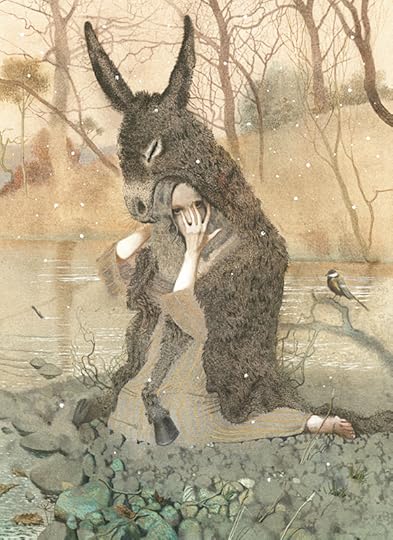 The illustrations by Nadezhda Illarionova are: A Meeting in the Woods (The Wild Swans), Picking Nettles (The Wild Swans), The Fickle Prince (The Little Mermaid), Mole and Mouse (Thumbelina), The Child Was Shivering (Thumbelina), and Donkeyskin. All rights to the art and text above are reserved by the artist and writers.
The illustrations by Nadezhda Illarionova are: A Meeting in the Woods (The Wild Swans), Picking Nettles (The Wild Swans), The Fickle Prince (The Little Mermaid), Mole and Mouse (Thumbelina), The Child Was Shivering (Thumbelina), and Donkeyskin. All rights to the art and text above are reserved by the artist and writers.
January 11, 2017
Four writers on fairy tales
Following on from yesterday's post, here are four more writers looking at the ways fairy tales pervade their lives and art....
"Once upon a time, the stories would begin. Once upon a time is no particular time, fictional time, fairy-story time. This is a doorway; if you're lucky, you go through it as a child, aurally, before you can read, and if you are very lucky, you become a free citizen of an ancient republic and can come and go as you please. These stories are deeply embedded in my imagination. As I grew up and became a writer, I found myself going back and using them, retelling them ever since, working partly on the principle that a tale which has been around for centuries is highly likely to be a better story than one I just made up yesterday; and partly on the deep sense that they can tell more truth, more economically, than slices of contemporary realism. The stories are so tough and shrewd formally that I can use them for anything I want -- feminist revisioning, psychological exploration, malicious humour, magical realism, nature writing. They are generous, true, and enchanted."
"What was their appeal? It's hard to be definite about that. The stories didn't have any direct application to our real lives. They weren't much good from a practicle point of view. At this time, we were living half the year in the Canadian north woods, and we knew if we went for a walk there, we were unlikely to come upon any castles, if we met any wolves or bears they wouldn't be the talking kind, if we kissed a frog it would most likely pee on us, and if we got lost, we wouldn't find any short-sighted, evil old women with patisserie cottages and child-sized ovens. Rescue, if any, would not be applied by princes. So it wasn't our outer lives that Grimms' tales addressed: it was our inner ones. These stories have survived as stories, over so many centuries and in so many variations, because they do make such an appeal to the inner life -- you could say 'the dreaming self' and not be far wrong, because they are both the stuff of nightmare and magical thinking. As Margaret Drabble says, there is a mystery in such stories which is beyond the rational mind."
"Like many others who turn into writers, I disappeared into books when I was very young, disappeared into them like someone running into the woods. What surprised and still surprises me is that there was another side to the forest of stories and the solitude, that I came out that other side and met people there. Writers are solitaries by vocation and necessity. I sometimes think the test is not so much talent, which is not as rare as people think, but purpose or vocation, which manifests in part as the ability to endure a lot of solitude and keep working. Before writers are writers they are readers, living in books, through books, in the lives of others that are also the heads of others, in that act that is so intimate and yet so alone. These vanishing acts are a staple of fairy tales and of children's fantasy books -- where young people travel on various adventures between levels and kinds of reality, and the crossing over is often an initiation into power and into responsibility. They are in a sense allegories first for the act of reading, of entering an imaginary world, and then of the way that the world we actually inhabit is made up of stories, images, collective beliefs, all the immaterial appurtenances we call ideology and culture, the pictures we wander in and out of all the time."
"Fairy tales are as ancient as the hills, but they never grow old. As society and culture change, as our world becomes a place Madame D'Aulnoy, Charles Perrault, and the Brother Grimm could never have dreamed possible, the wisdom of their tales remains relevant to our lives. Because, of course, the stories change with us. We tell them and re-tell them, and they morph and grow and stretch to fit the framework of our time and culture, just as they did when they were told around the fire after dark in times long past. In this high-speed technological age, an age in which 140 characters are deemed sufficient to transmit a meaningful message, these stories still have much to teach us. We would do well to listen."
The art today is by the English illustrator Angela Barrett, who lives and works in London.
Barrett trained at Maidstone College of Art and the Royal College of Art, then published her first illustrated book, The King, the Cat and the Fiddle, in 1983 -- which went on to win the Mother Goose Award Runner-up Prize in 1984. Since then, she has published many more books including The Snow Goose, The Hidden House, The Night Fairy, Joan of Arc, Ann Frank and The Orchard Book of Classic Shakespeare Stories, in addition to her celebrated fairy tale editions: Snow White, Beauty and the Beast, The Snow Queen, and The Emperor's New Clothes. Barrett has won the Smarties Award, and has been short-listed for the Kate Greenaway Medal and the Emil/Kurt Maschler Award.
Go here for an interview with the artist by fellow-illustrator Quentin Black.
Words: The Maitland quote is from Gossip from the Forest: The Tangled Roots of Our Forests & Fairytales (Granta, 2013); the Atwood quote is from Mirror, Mirror on the Wall: Women Writers Explore Their Favorite Fairy Tales, edited by Kate Bernheimer (Expanded Edition: Anchor Books, 2003); and the Solnit quote is from The Faraway Nearby (Penguin, 2014). All three books are highly recommended. The Juliet Marillier quote is from her essay on "Beauty and the Beast" (Seven Miles of Steel Thistles, August 2012), which is part of Katherine Langrish's excellent "Fairytale Reflections" series. All rights reserved by the authors.
Pictures: The Angela Barrett illustrations above are from Snow White, Beauty and the Beast, The Emperor's New Clotthes by HC Andersen, The Snow Queen by HC Amdersen, and The Snow Goose by Paul Gallico. All rights reserved by the artist.
Terri Windling's Blog
- Terri Windling's profile
- 708 followers


